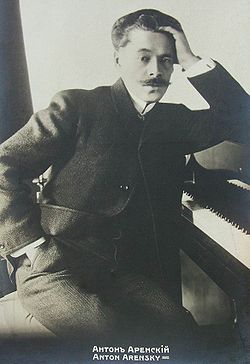Anton Stepanowitsch Arensky
Anton Stepanovich Arensky ( Russian Антон Степанович Аренский ., Scientific transliteration Anton Arensky Stepanovič * June 30 jul. / 12 July 1861 greg. In Novgorod ; † 12 . Jul / 25. February 1906 . Greg in Perkjärvi at Terijoki ) was a Russian composer .
Life
Arenski grew up in a music-loving affluent family, so that he could deal with music a lot as a child. After attending the Russo Music School in Saint Petersburg , in 1879 he began to study composition (with Nikolai Rimsky-Korsakov ) as well as counterpoint and fugue at the Saint Petersburg Conservatory . In 1882 he completed his studies with great success and the next year he was appointed as a composition teacher at the Moscow Conservatory , where he was appointed professor in 1889. In this role, Arensky trained many students who would later become well-known composers (including Sergei Rachmaninoff and Alexander Scriabin ). In the mid-1880s, Arenski suffered severe mental illness (not least because of an unhappy marriage). In 1895 he resigned from all his offices and took over the leadership of the Imperial Court Choir in Saint Petersburg. Arenski held this position until 1901. After that he worked as a freelancer, but received a good pension. His last years were overshadowed by a tuberculosis disease, which was to lead to his death, as well as by addiction to drinking and gambling. Marija Lvovna Dillon created his grave monument .
The Arenski Glacier in Antarctica is named in his honor.
style
Arenski never developed a distinct personal style; initially his works were significantly influenced by his teacher Rimsky-Korsakov , and later by Pyotr Ilyich Tchaikovsky . In addition, however, influences from Frédéric Chopin and Robert Schumann can be recognized, so that despite the frequent use of folk song melodies, his works do not sound particularly "Russian" compared to his Russian contemporaries (such as Alexander Glasunow and Vasily Kalinnikow ). Some French elements can be made out. In general, Arenski avoided drama and strong conflicts and gave the lyrical element a more important role. Sometimes his works (especially for piano) approached salon music; Arensky was also frequently confronted with accusations of eclecticism . All this probably led Rimsky-Korsakov to predict that Arensky would soon be forgotten.
However, many of Arenski's works are of such high quality that it is worthwhile to study them more closely. In chamber music in particular, he is at the height of his creative abilities. His two piano trios are undisputed masterpieces that are characterized by lively élan, melodic inventiveness and subtle humor and easily withstand comparison with the compositions by Felix Mendelssohn Bartholdy , Robert Schumann and Johannes Brahms for this line-up.
Works
- Orchestral works
- Symphony No. 1 in B minor, Op. 4 (1883)
- Symphony No. 2 in A major op.22 (1889)
- Suite No. 1 in G minor, Op. 7 (1885)
- Intermezzo, op.13
- Suite No. 2 op.23 Silhouettes (1892, originally for 2 pianos)
- Suite No. 3 in C major op.33 Variations (1894, originally for two pianos)
- Piano Concerto in F minor, Op. 2 (1882)
- Violin Concerto in A minor op.54 (1901)
- Drama music
- Vocal music
- Dream on the Volga , Opera op.16 (1888)
- Raffael , Opera op.37 (1894)
- The fountain of Bakhchisarai , cantata op.46 (1899)
- Nal and Damajanti , Opera op.47 (1903)
- Choirs
- Songs
- Chamber music
- String Quartet No. 1 in G major op.11 (1888)
- String Quartet No. 2 in A minor op.35 for violin, viola and two violoncellos (1894, 2nd movement for string orchestra arranged as variations on a theme by Tchaikovsky op.35a)
- Piano Trio No. 1 in D minor, Op. 32 (1894)
- Piano Trio No. 2 in F minor, Op. 73 (1905)
- Piano quintet in D major op.51 (1900)
- Piano music
- 5 suites for 2 pianos (No. 1 op.15, 1884, No. 2 op.23 Silhouettes , 1892, No. 3 in C major op.33 Variations , 1894, No. 4 op.62, No. 5 op. 65 children's suite for piano four hands)
- smaller pieces
literature
- Wilibald Gurlitt , Carl Dahlhaus (editor): Riemann Musik-Lexikon. In three volumes and two supplementary volumes. Arensky, Anton Stepanowitsch. 12th completely revised edition. 1. Personal section A – KB Schotts-Söhne, Mainz 1959, p. 48 (first edition: 1882).
- Wilibald Gurlitt , Carl Dahlhaus (editor): Riemann Musik-Lexikon. In three volumes and two supplementary volumes. Arensky, Anton Stepanowitsch. 12th completely revised edition. 4. Supplementary volume, personal section A – KB Schotts-Söhne, Mainz 1972, p. 33 (first edition: 1882).
Web links
| personal data | |
|---|---|
| SURNAME | Arensky, Anton Stepanowitsch |
| ALTERNATIVE NAMES | Аренский, Антон Степанович (Russian); Arenskij, Anton Stepanovič (scientific transliteration) |
| BRIEF DESCRIPTION | Russian composer |
| DATE OF BIRTH | July 12, 1861 |
| PLACE OF BIRTH | Novgorod |
| DATE OF DEATH | February 25, 1906 |
| Place of death | Perkjärvi near Zelenogorsk (Saint Petersburg) |

